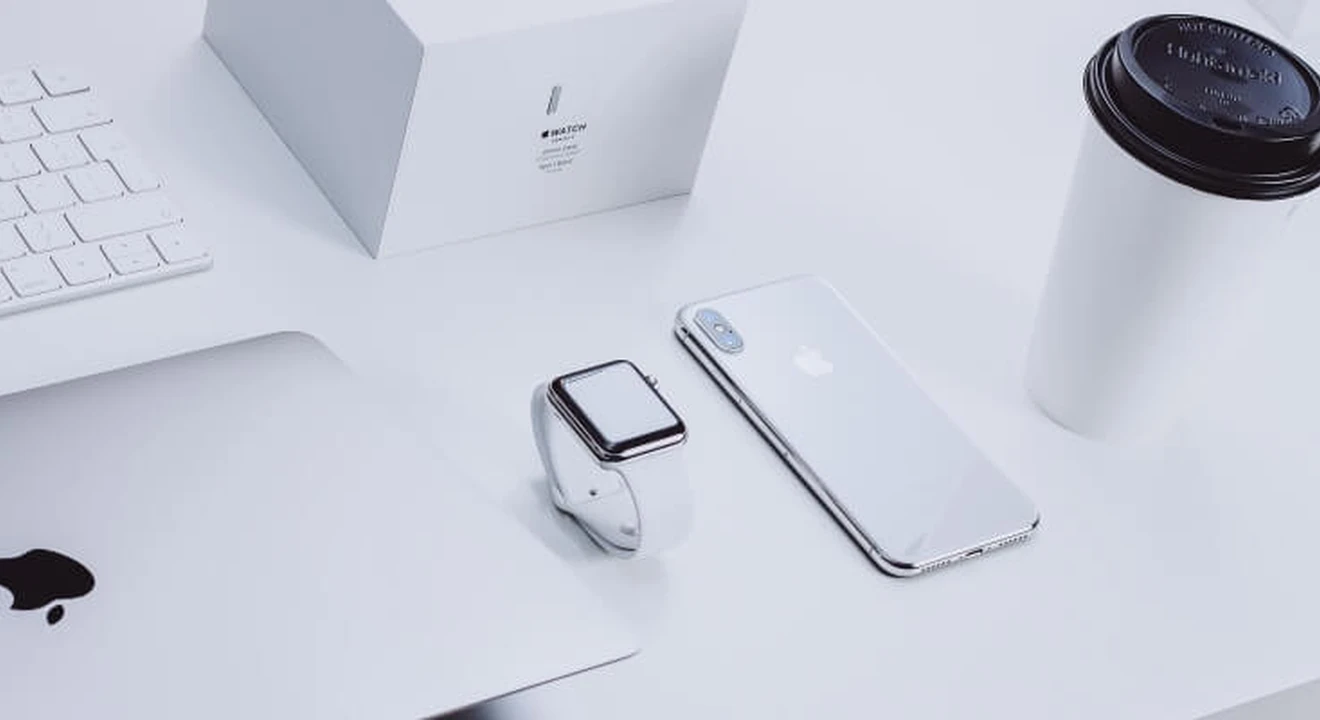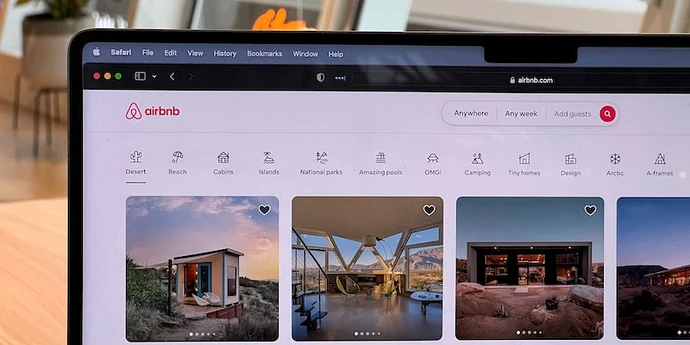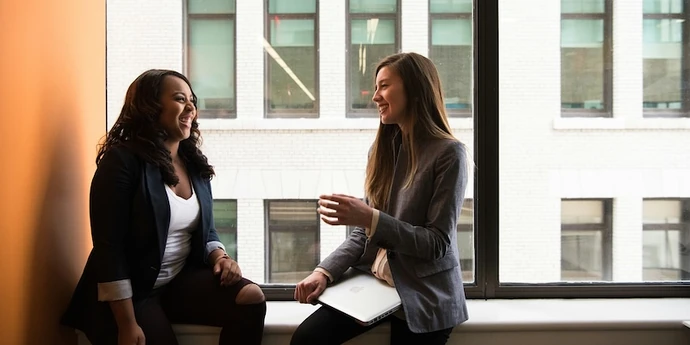In this guide, we’re going to cover everything you need to prepare for product manager interviews at Apple.
Information on Apple job interviews online is minimal, especially for the PM position. But it’s no secret that its PM interviews are challenging. You’ll be up against an unpredictable interview process and questions that are specific to Apple.
The good news is that the right preparation will make all the difference. That’s why we’ve prepared this ultimate guide. To put it together, we’ve gathered insights from expert Apple PM coach John, reviewed real candidate reports, and gathered insights from Apple insiders online.
Below, you’ll find a detailed breakdown of the interview process, some sample questions, and expert tips—everything you need to walk into each round with confidence.
Here's an overview of what we will cover:
Click here to practice 1-on-1 with Apple PM ex-interviewers.
1. Apple product manager role and salary ↑
Before we dive into your Apple product manager interviews, let’s take a look at the role itself.
1.1 What does an Apple product manager do?
A product manager at Apple is responsible for leading the creation, development, and monitoring of customer-centric products, services, and experiences across Apple’s entire ecosystem: electronic products such as iPhone, iPad, Apple Watch, Apple Music, Apple TV+, Maps, other apps, and more.
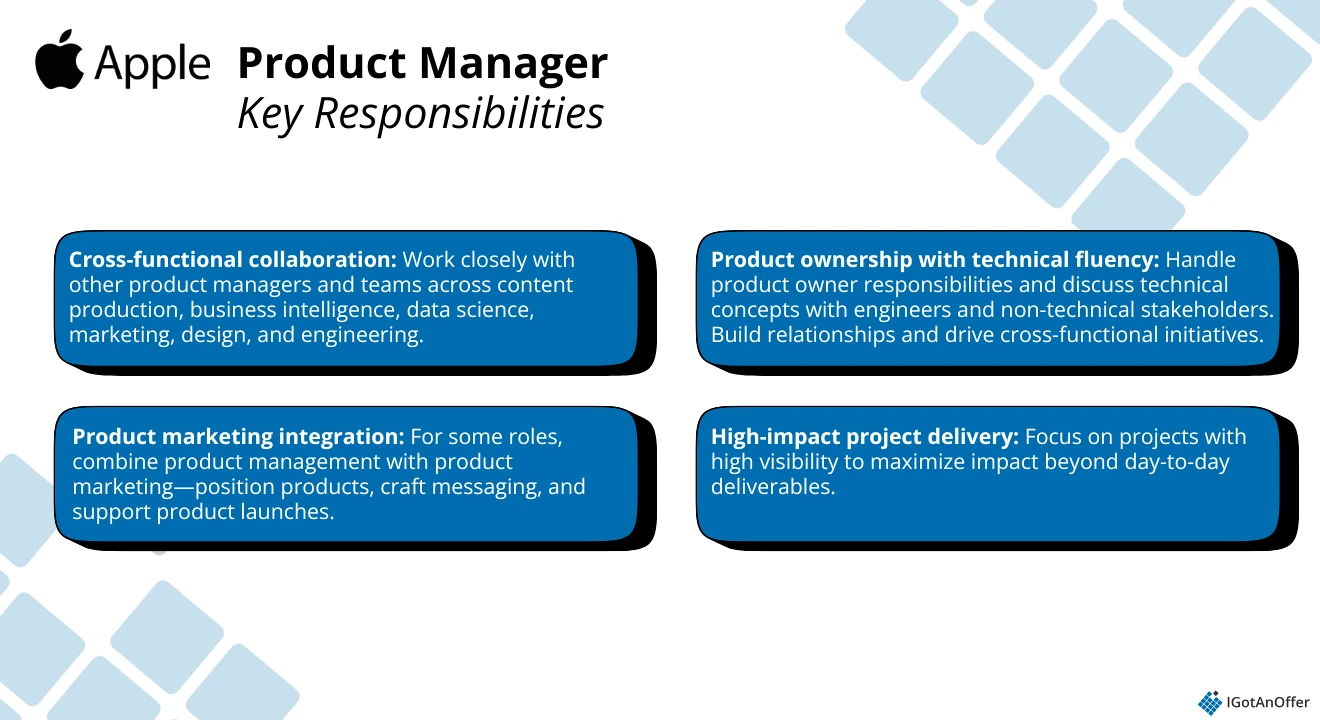
As a product manager, the fruits of your work will show in the results and their measurable impact. According to one former ex-Apple PM coach:
“Organizing chaos and building coalitions is a huge success trait. Success is defined by people who deliver. Delivering your top priority items every time is key. Getting involved in high-visibility, important efforts is the best place to be.” — John, Apple Senior Technical Product Manager
What are the required skills for an Apple Product Manager?
Unlike other top tech companies that focus on MVPs (minimum viable products), Apple is focused on delivering products that exceed expectations, so it has no problem taking its time before launching. This product culture influences how they choose their personnel.
Based on current product manager posts on Apple’s job boards, key qualifications for an Apple product manager include:
- Education / experience: Most roles require a BA/BS degree or relevant work experience.
- Product management experience: Some roles require 7+ years of experience and involvement in at least one product development cycle.
- Analytics & data skills: Experience in analytics, experimentation, and data storytelling.
- Cross-functional collaboration: Proven experience working with cross-functional teams.
- Agile/Scrum: Ability to lead Agile or Scrum projects.
- Role-specific nuances: Each team may have slightly different qualifications and requirements.
As expert PM coach John shares, Apple wants highly qualified people who are willing to commit, build one’s reputation over time, and put in the work patiently. If you expect quick wins and fast returns, then you might not fit in Apple’s culture.
1.2 How much does an Apple product manager make?
Based on the computations from Levels.fyi, the median total compensation package of an Apple PM is $310K as of late 2025, which is 39% higher than the US average for that role.
Below you can see the average base salary of the different product manager positions at Apple US, as of late 2025, based on Levels.fyi data:
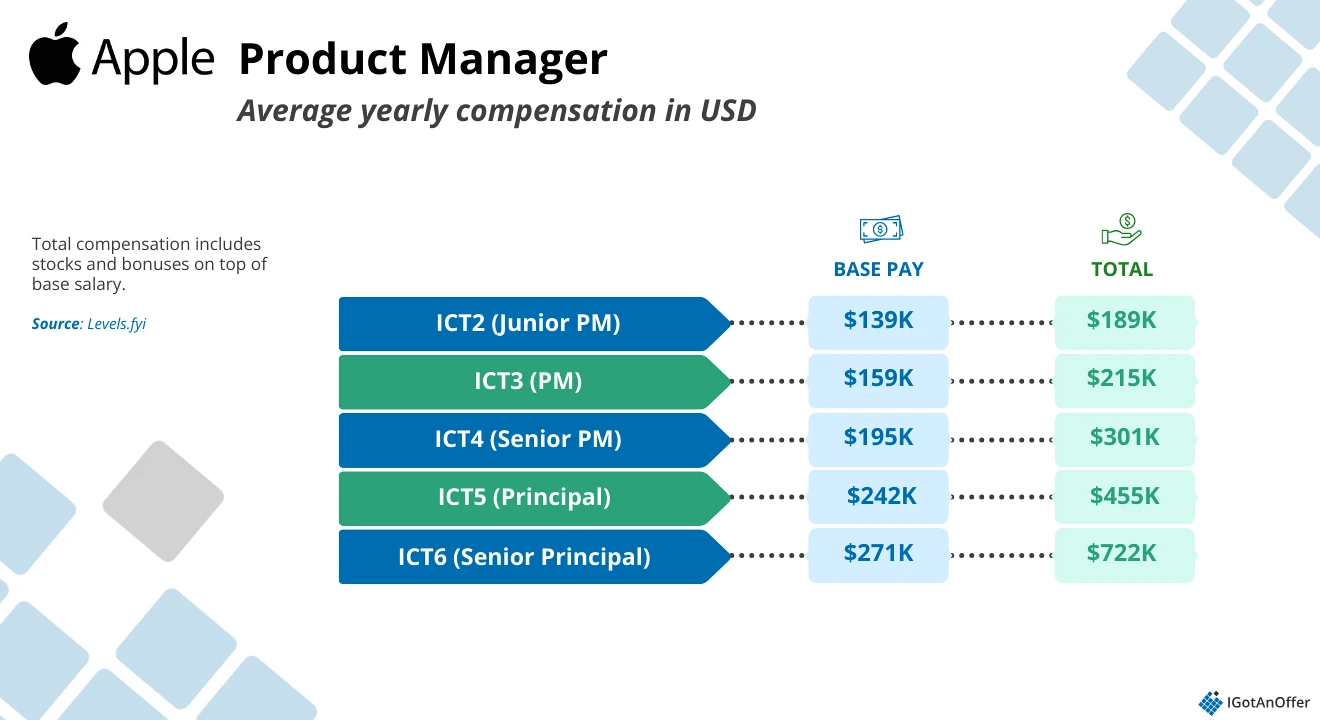
Location plays a part in the difference in base salary, based on Glassdoor data. To compare:
- Apple India PM: Est. average of $86K/year
- Apple UK PM: Est. average of $190K/year
- Apple US PM: Est. average of $310K/year
Ultimately, your interview performance will largely determine your offer, which is why working with our Apple PM interview coaches can provide such a significant return on investment.
And remember, compensation packages are always negotiable, even at Apple. So, if you do get an offer, don’t be afraid to ask for more. If you need help negotiating, check out our Apple job offer negotiation guide and product manager salary negotiation guide for tips.
If you need expert guidance on negotiating, consider booking a session with one of our salary negotiation coaches.
2. Apple product manager interview process and timeline ↑
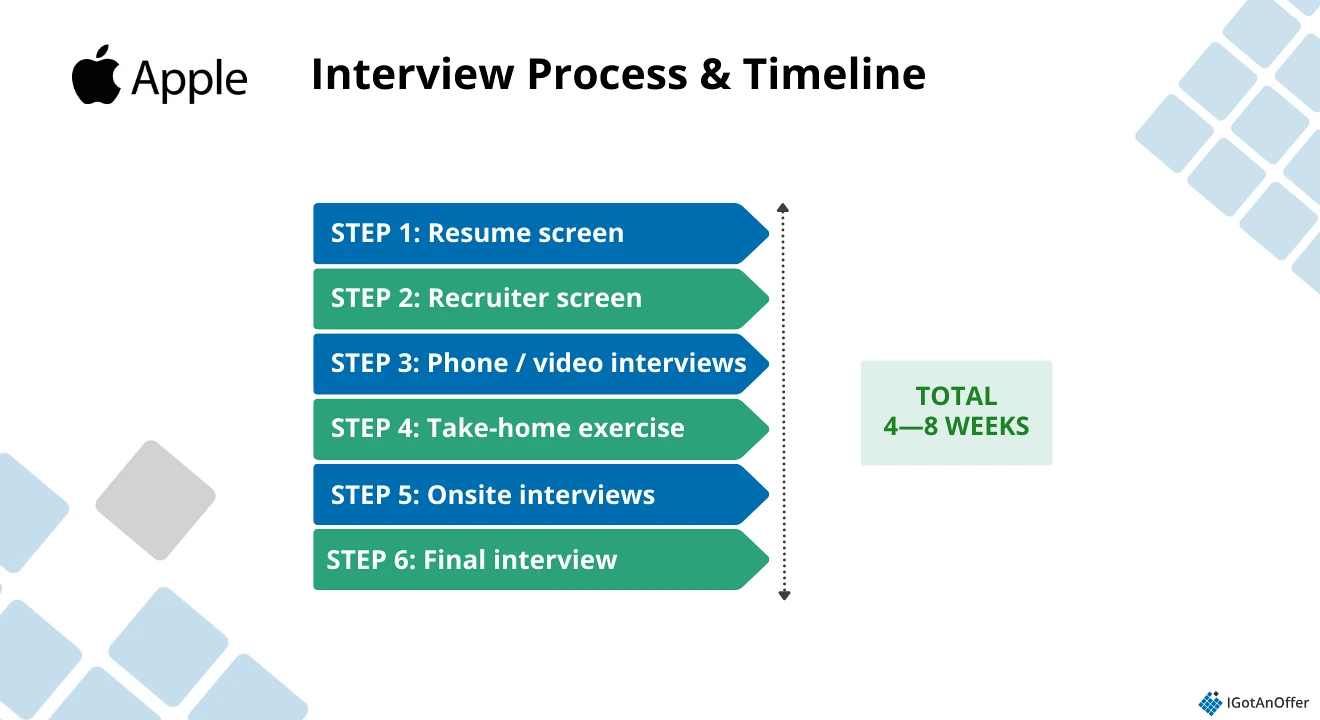
The interview process for Apple PMs typically takes about 4-8 weeks to complete, although it could be a bit faster or slower depending on the particular location and position for which you’re applying.
Apple has a functional organizational structure. This gives its functional areas (e.g., design, engineering, etc.) more autonomy than most companies of its size. Partly because of this, there is no standardized interview process, and your experience can vary widely depending on which team you’re applying for.
This makes Apple interviews particularly difficult to prepare for.
To give you an idea of what may be in store for you, we’ll cover the steps that previous candidates have reported on Glassdoor, and Blind. Here’s a quick overview:
- Resume, cover letter, and referrals
- Recruiter screen
- Phone/video interviews
- Take-home exercise
- Onsite interviews
- Final interview
If you are interviewing for a product leadership position (VP, Director, Group PM), read our guide on how to prepare for product leader interviews.
2.1 Resume, cover letter, and referrals
First, recruiters will look at your resume and assess if your experience matches the open position. This is the most competitive step, and millions of candidates do not make it past this stage.
You can use this free PM resume guide to help tailor your resume to the position you’re targeting.
And if you’re looking for expert resume feedback, you can also get input from our team of ex-FAANG recruiters, who will cover what achievements to focus on (or ignore), how to fine-tune your bullet points, and more.
2.2 Recruiter screen
Once you’ve been invited to interview with Apple, you’ll first speak with a recruiter on a phone screen. This is universal across all teams.
During this call, you should expect the recruiter to ask you some typical resume and behavioral questions. So practice discussing your key experiences, especially those that you’ve included in your application, as well as your most impressive work accomplishments.
They'll be looking to evaluate your fit with Apple’s culture, your overall qualifications for the role, and whether you have a chance of succeeding in future interview rounds.
At this point, the recruiter will likely give you an idea of what interview steps are in store for you. If not, don’t hesitate to ask clarifying questions about the process ahead.
2.3 Phone/video interviews
After the initial recruiter phone screen, you'll have your first PM-focused interviews. They will take the form of one or multiple video or phone calls, each lasting 30-60 minutes.
These interviews will be with an Apple hiring manager or product manager on the team for which you’re applying. Be prepared to answer common PM interview questions, as well as more targeted questions about your past experience.
For PM roles, Apple highly values relevant hands-on experience. Be prepared to talk about your past roles. Highlight proficiencies, specific achievements, and strengths that you think make you a great candidate for the role.
You’ll find more details on the types of questions to expect and how to prepare for them in section 3 of this guide.
2.4 Take-home exercise
In some cases, you will be asked to complete a written take-home exercise. This may occur after or between the initial interviews we’ve described above. Not all candidates will be assigned this exercise.
The intent of this assignment is to see how you approach the types of problems you might encounter on the job. The exercise will likely focus on a typical PM question, such as a metric or technical problem.
In other cases, you may be given materials for a presentation that you’ll be given a week to prepare. You’ll be expected to present this to a panel during one of the rounds in your onsite interview.
2.5 Onsite interviews
The next round is the on-site portion, which is a loop of seven to ten separate interviews. This may occur in person or virtually. If you interview in person, one of the rounds will take the form of a lunch interview on the Apple campus.
You'll have at least one PM interview (though you could have more than one), and you'll also have interviews with a variety of people in your future team. For example, you might meet with other managers, directors, senior engineers, etc.
The types of questions you’ll be asked fall into the following categories:
We’ll dive deeper into these question types in section 3 below. If you’re well prepared to answer these questions, then you’ll be well prepared for the onsite interviews as a whole.
2.6 Final interview
In some cases, candidates who pass the onsite rounds are invited to one final interview with a senior member of the team.
This usually takes the form of a relatively short but in-depth interview that tests any areas the team felt were missing from the onsite rounds, as well as your overall culture fit at Apple. Prepare for this interview as you would the onsite rounds, using the practice questions in section 3 and the tips in sections 4 and 5.
If all goes well, this or the onsite round will be your last step as a candidate, and from there, you just have to wait to (hopefully) receive your offer.
3. Apple product manager example questions ↑
Below, we have compiled a set of example PM interview questions to help you practice for your Apple interviews. You’ll be asked a wide range of questions, which we've grouped in six buckets:
Below, we break down each question type and provide sample interview questions sourced from real Apple PM candidate reports on Glassdoor and Blind, as well as some questions from other top tech companies to round out your preparation.
3.1 Behavioral questions ↑
Apple places equal weight on leadership skills and technical ability. Apple recruiters ask leadership and behavioral questions to assess your approach as a product manager and your ability to work cross-functionally, influence decision-makers, and push projects through to the end.
This is the most highly represented question category among past candidate reports, so pay extra attention to this section. We’ve split the questions into three sub-categories:
- General behavioral: Your past experiences and behaviors at work, how you handle specific professional situations using your leadership, interpersonal, communication, and problem-solving skills.
- Motivational fit: Your understanding of the company’s core values, and whether your own values, motivations, and aspirations make you well-suited for the position.
- Leadership: Your ability to guide teams, make decisions, and influence outcomes through clarity, accountability, and collaboration. Keep in mind that Apple places as much emphasis on leadership skills as technical ability.
When answering questions, keep in mind Apple’s seven core values and find ways to show that you align with them. Prepare examples from your past that represent those values.
Example behavioral questions asked at Apple PM interviews
General behavioral questions
- What is your proudest accomplishment?
- Tell me about a challenging moment in your career.
- Tell me about a time you had to convince someone when you had no authority over them.
- Tell me about a time you had to make a decision with a lot of ambiguity.
- Tell me about a time when you had a disagreement with one of your colleagues or managers.
- Tell me about a time you failed.
- Tell me about a time when you felt appreciated at work.
- Can you provide an example of a challenging project you successfully completed?
Motivational fit questions
- Why Apple? (See sample answer from similar Amazon interviews here.)
- Why this role?
- Why product management?
- What are your short- and long-term goals?
- How do you keep yourself organized?
- What skills can you bring that other prospective employees can’t?
- When was the last time you learned something new?
- What three words would you use to describe Apple’s products?
Leadership
- How much experience do you have with project management?
- How do you handle changes or unexpected obstacles during a project?
- How do you manage people on teams you may not get along with?
- Have you ever had to advocate for a customer, and if so, how?
For more information, check out our guide on PM behavioral interview questions, which includes an effective answer framework and sample answers to the top 8 most commonly asked questions.
3.2 Product questions ↑
As a product manager, your core responsibilities include designing new product features and improving existing ones. Apple interviewers will ask questions related to product design and product improvement to assess your customer empathy, creativity, and ability to use a structured approach to design products.
Product design questions will likely focus on Apple’s own products, so you’ll want to have a detailed understanding of the company’s latest products. Be prepared to create a high-level product design with specific features, while explaining your implementation and product timeline.
Product improvement questions will probe into your ability to further innovation, identify gaps and flaws in existing products, and make smart design decisions that help Apple maintain its competitive edge.
Example product questions asked at Apple PM interviews
Product design
- Design a voice assistant product for kids.
- Design a computer keyboard.
- Design an alarm clock for the blind.
Product improvement
- What's your favorite Apple product and why? How would you improve it?
- What feature(s) would you like to see added to "product X"?
- Tell me about your favorite product that’s not an app or website.
For more information, take a look at our articles on product design questions and product improvement questions.
3.3 Strategy questions ↑
Strategy questions test whether you're comfortable thinking about the complex considerations good PMs need to take into account when making product decisions. At Apple, you’ll frequently be expected to take the lead on projects with minimal input from others. You’ll need an excellent sense for strategy.
Be ready to share the processes and methodologies from your own PM playbook with the interviewer, and communicate how you break down complex problems. You’ll be asked to discuss your product vision and how you work with other teams to build out a roadmap.
Example strategy questions asked at Apple PM interviews
- What’s more important, fixing the customer’s problem or creating a good customer experience?
- Our engineering teams are used to employing x methodologies. Have you used them in the past? What is your opinion of them?
- What are your favored tools to manage x process (workflow, people management, wire-framing)? Why?
- Imagine you’re the CEO of Apple — what product would you eliminate from the lineup? [TIP: Don't say iCloud.]
- Describe a testing method you have implemented. Describe the requirements for a project testing devices.
- Do you prefer Waterfall or Agile management?
For more example questions and information, check out our article on how to answer product strategy interview questions.
3.4 Technical questions ↑
As a product manager at Apple, it’s important for you to understand technical concepts and explain them to others in a simple manner, communicate at a high level with engineers, and think like a developer.
To test this, interviewers will typically ask you one or two technical questions during your interview process. Apple’s technical questions vary widely depending on what team you’re applying for and what your resume says. If you list technical skills on your resume, expect to be tested on them.
Example technical questions asked at Apple PM interviews
- Use a whiteboard to teach me something, work-related or otherwise.
- Walk me through the components needed to build a data processing and reporting system.
- Develop an algorithm that can detect if a string is a palindrome.
- Describe shell sort and its advantages and disadvantages.
- Describe the 3 different indices and describe the properties of each. In what situation would you want to use one over the other?
- How would you face a technical challenge you have never encountered before? Describe your methodology step by step.
For more example questions and information, check out our article on how to answer technical product interview questions.
3.5 Analysis questions ↑
Finally, Apple uses metrics to assess product success and what its team should start on next. Your interviewers will therefore ask you one or two questions about what metrics you would track for a given situation, or how you would investigate changes in a given metric.
At the time of this article, there is very little Glassdoor data on Apple’s data analysis interview questions, so all of the following examples come from Amazon, Meta, or Google.
Example analysis questions asked at Apple PM interviews
- What metrics would you use to determine success for the Facebook Newsfeed?
- YouTube traffic went down 5% — how would you report this issue to the executive team?
- What metrics did you use to measure the successful launch of your product?
- What metrics would you use to measure the success of Facebook’s “Save Item” feature?
- How would you measure the success of the new YouTube Player UI?
- There's been a 15% drop in usage of Facebook Groups — how do you fix it?
- You have just localized an e-commerce site in Spain and now see that traffic has reduced — what could be the reasons?
For more example questions and information, check out our article on how to answer product metric interview questions.
4. Apple product manager interviewing tips ↑
You might be a fantastic product manager, but that’s not necessarily enough to ace your interviews at Apple. Interviewing is a skill in itself that you need to learn.
Let’s look at some key tips to make sure you approach your interviews right.
4.1 Come as your best self at work
Whether you’re coming in for a virtual or on-site interview, be punctual and arrive at least 15 minutes before your scheduled interview. As for your attire, dress comfortably but keep it smart, polished, and work-appropriate.
If you have a virtual interview, make sure you’re in a distraction-free environment. Test your equipment beforehand and preview your interview link an hour before to ensure everything works fine.
4.2 Be ready to talk about YOU
You’ll find that the majority of the reported Apple interview questions revolve around your past job experiences. Be prepared to talk about yourself, your accomplishments, and how you’ve made an impact in your previous roles. Be sure to focus on how these experiences make you a qualified and competitive candidate, based on the requirements for the job.
4.3 Center on the company’s core values
Apple is a massive technology company with products spanning an ecosystem of consumer devices, entertainment, and cloud infrastructure. You can study the following resources:
When answering culture fit and behavioral questions, share stories from past experiences that align with Apple’s core values. When designing a product or a strategy, consider how your answer aligns with these values.
Research Apple’s competitive position, especially versus Android and Google Cloud. Be ready to articulate what differentiates Apple’s offerings—not just in marketing terms, but in ways that matter to everyday users.
As Mark, a senior PM formerly of Meta and Google, says: "In product design questions, you're going to literally want to cite the company's mission back at them. If you're interviewing remotely, write it on a post-it note and stick it on your laptop!"
4.4 Ask clarifying questions
Some of the questions you will be asked will be quite ambiguous. In those cases, you’ll need to ask clarifying questions to get more information about the problem and to reduce its scope.
Jumping straight in without asking questions first will be a red flag to the interviewer and hinder your answer.
But don’t just ask any questions; be smart about them.
“Sometimes the strongest signal you send is what you want to know about the problem,” Laura Terheyden, former head of Recruitment at Airbnb, says in this Airbnb interview cheat sheet.
For instance, if you were asked, “What would be your 10-year strategy if you were CEO?” you can respond by asking some questions about the company’s current situation and any business objectives the interviewer may have in mind. This way, you’ll have a better understanding of what the company needs in the coming years and make more informed strategic decisions.
4.5 Check in with your interviewer
Interviewers differ in their willingness to provide hints. Some may wait for you to ask about customer or product details, while others expect you to make assumptions on your own.
Gauge this by asking a direct question or specifying your assumptions. If the interviewer tends to offer specifics, they’ll engage. If not, limit additional questions to demonstrate your ability to make decisions independently.
4.6 Emphasize cross-functional collaboration
Apple PMs work closely with engineering, design, sales, support, and customer-facing teams. The ability to influence without authority is essential in cross-functional collaboration.
Demonstrate your ability to:
- Influence without authority: Show how you've driven alignment when you don't control resources.
- Build consensus among diverse stakeholders: Enterprise products have many constituents. Prove you can navigate competing priorities.
- Communicate technical concepts to non-technical audiences: Your sales team needs to understand what you're building and why it matters.
- Navigate organizational complexity: Oracle is a large company. Show you understand how to work in complex environments.
- Manage conflicting priorities across teams: Engineering wants to pay down tech debt. The sales team wants new features yesterday. Show how you balance these tensions.
Make sure your answers to behavioral questions showcase these collaboration skills using specific examples.
4.7 Demonstrate a data-driven approach
Apple is looking for product managers who can make decisions based on data and relevant metrics.
In an interview situation, it's okay to make assumptions because you might not have access to the facts and data. But make it clear that in real life, you would seek out a data-driven approach. Show your thought process and call out the trade-offs you’d made as you arrive at a solution.
If you find that your answer about a previous role may reference sensitive information, note this to your interviewer and avoid disclosing those details. One of Apple’s values is privacy, and it won’t require you to divulge sensitive or confidential information.
4.8 Demonstrate user empathy
Apple wants product managers who can empathize with its users.
When answering a PM interview question, your first instinct should be to focus on the user. Identify who uses the product, why, and what the use cases are. Avoid designing a product based solely on personal preferences.
That said, do as Apple does and don’t just rely on customer feedback or user preference. When answering questions regarding user experience, propose how you plan to tap into internal expertise to inform your design solution.
One of Apple’s values is accessibility, ensuring that all users have equal access to their products and services. When answering design questions, highlight the accessibility aspect of your proposed solution.
4.9 Learn a framework for answering questions
Apple wants to see structured thinking. Using a consistent framework helps you organize your answers and demonstrate clear reasoning.
For product design questions, you can learn more about using the BUS (Business objective, user problem, solution) method here.
For behavioral questions, the STAR method (Situation, Task, Action, Result) is a popular approach that’s easy to remember. However, we've found that candidates often find it difficult to distinguish between Task and Action. Some also forget to include lessons learned in the results step, which is especially crucial when discussing past failures.
So, we've developed a better alternative: the IGotAnOffer SPSIL method (Situation-Problem-Solution-Impact-Lessons) to address some of the pitfalls we've observed. You can dive deeper into the IGotAnOffer SPSIL method here.
The bottom line is that Apple wants to see you extract learning from experiences and apply it forward. Many candidates skip this step, leaving interviewers to wonder if you actually learned anything.
Practice this framework until it becomes natural, but don't let it constrain your thinking. The framework should help you communicate clearly, not force artificial structure.
4.10 Don’t get stuck on a framework
As we just said above, frameworks are extremely helpful. However, some of our successful candidates have mentioned that excessive reliance on frameworks may hinder performance.
During the interview, trust your instinct, and don’t be afraid to deviate from the framework if needed. A framework is there to help you craft a better answer, not make you twist your answer to fit the framework.
4.11 Save questions and feedback for your interviewer
You’ll have a few minutes to ask your interviewer questions as the interview wraps up. Arriving without questions may suggest a lack of interest in the company or the role, so you make sure you have a few prepared beforehand.
4.12 Treat the interview like a conversation
Finally, keep in mind that the interview is a two-way discovery process. While the interviewer assesses if you’re a good fit for Apple, you’re also evaluating if the company aligns with your aspirations and preferences.
5. Preparation plan ↑
Now that you know what questions to expect, let's focus on preparation.
Below, you’ll find links to free resources and four introductory steps to help you prepare for your Apple PM interviews.
5.1 Deep dive into the product / organization
First, get further acquainted with Apple's values using the video below and the rest of their Brand Values YouTube playlist.
Here are some more resources:
- Apple Core Values
- Apple Investor Relations
- Apple Strategy Teardown (from CB Insights)
- Apple’s Company Culture: An Organizational Analysis (by Panmore Institute)
- Apple’s Marketing Mix: 4P Analysis (by Panmore Institute)
- Apple Mission and Vision Statement Analysis
- How Apple is Organized for Innovation (by Harvard Business Review)
- Apple's Culture Rejects the Conventional Wisdom of Product Design (by Inc)
5.2 Learn a consistent method for answering PM interview questions
As mentioned previously, Apple will ask you questions that fall into certain categories, like behavioral, product, strategy, and technical questions. Approaching each question with a predefined method will enable you to build strong interview habits.
Then, when it comes time for your interviews, these habits will reduce your stress and help you to make a great impression.
If you’re just looking for a jump-off point, you can start learning about the different question types you’ll need to master in the following PM interview guides:
General
Product
- Product sense questions
- Product design questions
- Product improvement questions
- Product execution questions
Others
- Prioritization questions
- Strategy questions
- Metric questions
- Technical questions
- Estimation questions
Once you’re in command of the subject matter, you’ll want to practice answering questions. But by yourself, you can’t simulate thinking on your feet or the pressure of performing in front of a stranger. Plus, there are no unexpected follow-up questions and no feedback.
That’s why many candidates try to practice with friends or peers.
5.3 Practice with peers
If you have friends or peers who can do mock interviews with you, that's an option worth trying. It’s free, but be warned, you may come up against the following problems:
- It’s hard to know if the feedback you get is accurate
- They’re unlikely to have insider knowledge of interviews at your target company
- On peer platforms, people often waste your time by not showing up
For those reasons, many candidates skip peer mock interviews and go straight to mock interviews with an expert.
5.4 Practice with experienced PM interviewers
In our experience, practicing real interviews with experts who can give you company-specific feedback makes a huge difference.
Find an Apple product manager interview coach, so you can:
- Test yourself under real interview conditions
- Get accurate feedback from a real expert
- Build your confidence
- Get company-specific insights
- Learn how to tell the right stories, better
- Save time by focusing your preparation
Landing a job at a big tech company often results in a $50,000 per year or more increase in total compensation. In our experience, three or four coaching sessions worth ~$500 make a significant difference in your ability to land the job. That’s an ROI of 100x!






